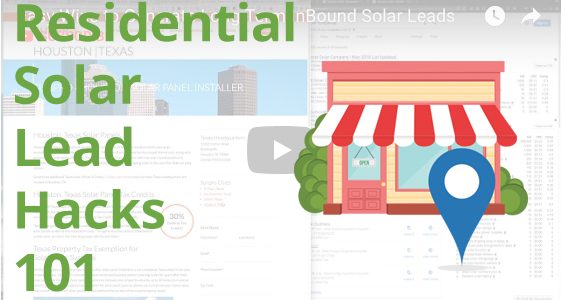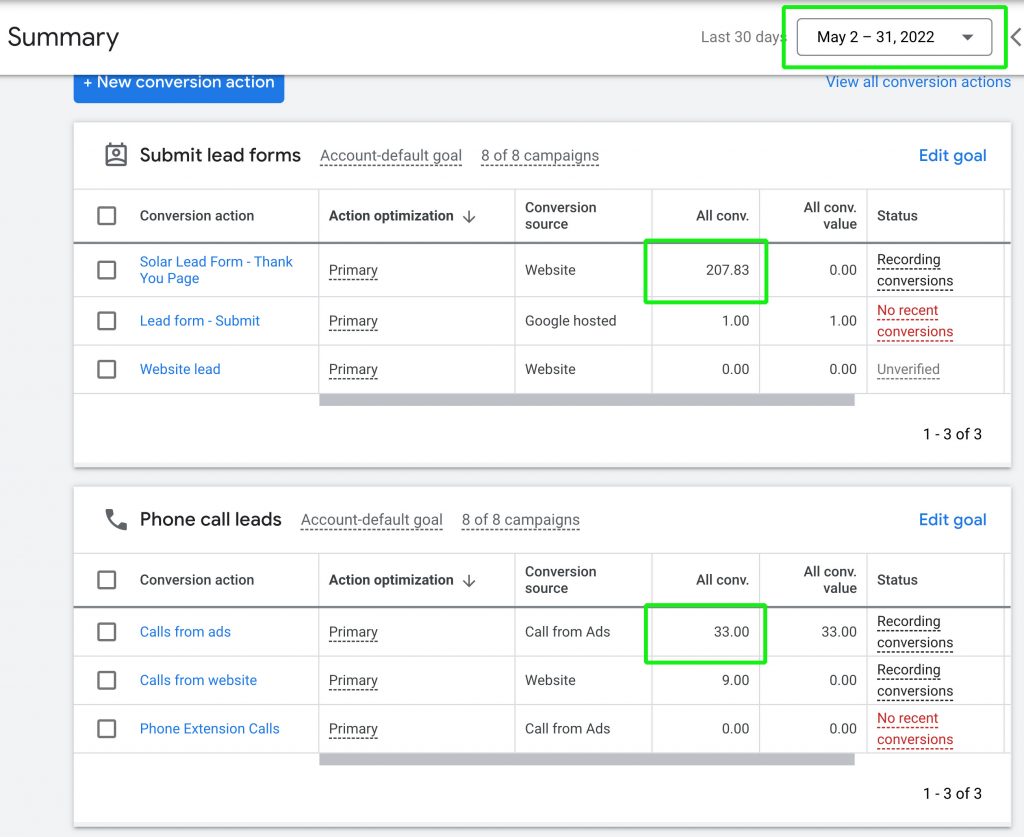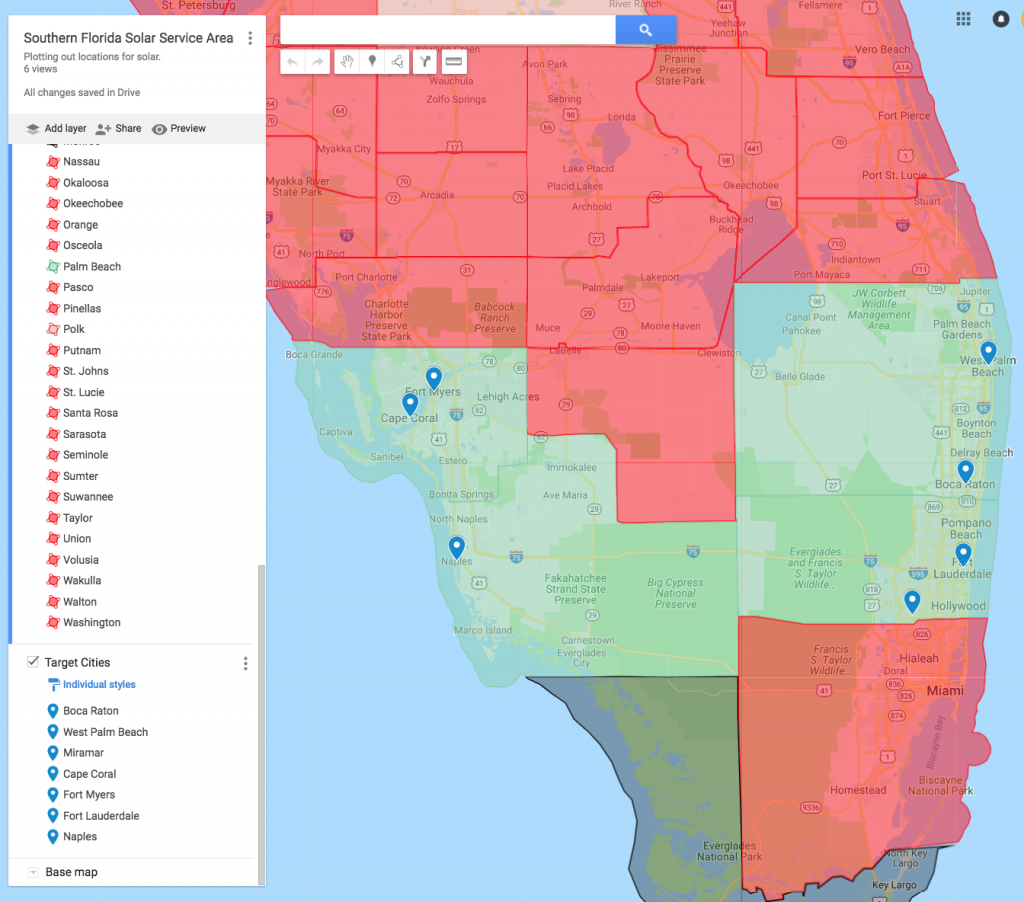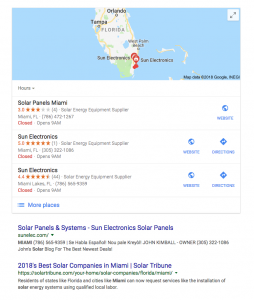Our Proven Residential Solar Leads Program
We rely on 3 channels to build robust, long term lead generation systems for our solar clients: Facebook Ads, Google Ads, and organic search (aka SEO). We do not sell individual leads or appointments. We build lead generation systems our clients OWN AND CONTROL.
Please do not contact us to purchase leads or appointments as we do not offer this. We work with established solar organizations only who value owning their own lead generating assets that they fund and pay our agency to build and manage.
Driving Immediate Solar Leads with Facebook & Google Ads
To get leads in the door ASAP, we recommend we building out Facebook and Google Ads lead campaigns. Both Google and Facebook Ads are like locomotives and require data to build momentum. The more data and spend we input into our account, we build more conversion data making the system more adept and cost efficient at finding who are ideal lead type is. Depending on how competitive your area is, Facebook Ads can require more test budget at first to yield the converting audiences, ad copy, creatives, and landing pages. Google Ads is a bit more straight forward. We have the data on highest performing ad groups, keywords, ad copy, and landing page templates to begin testing. As a solar specific marketing agency, we bring a considerable advantage in being able to build best practice campaigns built on years of historical data on what works and what doesn’t.
Google Ads for Solar
This is an east coast solar company we’ve been working with for a year now. In the past month of May we generated over 200+ solar form submits and 33+ calls through a landing page bidding on various solar related keywords. For this particular client, call volume could be even higher, as we aren’t running a phone extension on the ad (client request due to confusion with a utility company).
260+ Residential Solar Leads in May 2022 from Google Ads
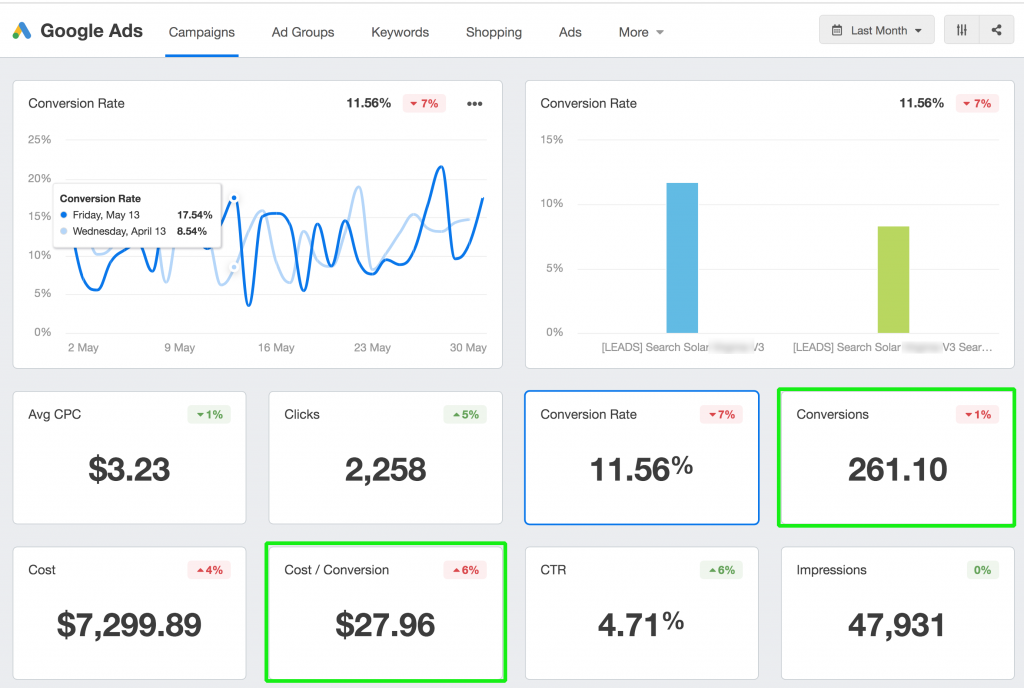
Phone Calls and Landing Page Form Submits
Facebook Ads for Solar
Location and relative competition is the biggest predictor for Facebook lead cost. In California for example, we have a multitude of competitors from publicly traded solar companies, to multi-million dollar lead generation companies all vying for the same eyeballs. As such cost per lead in California from Facebook Ads is much higher than a midwest or east coast state for example. We need to be more creative about our targeting and offers for higher competition states like California and Florida. Back in 2018, Facebook Ads were cheap. These were 18 solar leads at around $3 per lead. This is the lowest cost per lead we’ve ever seen in an unlikely Midwestern state in the dead of winter. Just goes to show how much potential there is to capitalize on in early stage consumer solar markets. Today in California, with a bit of repositioning, and highly education based ads, we are generating around $20-$60 leads on Facebook. With our managed Facebook Ad service, we build both Lead Form campaigns and Landing Page campaigns. Like Google Ads, the more money we spend on our account, the better data we build that allows our account to find those ideal homeowner audience targeting. This is why it’s imperative you invest in your own accounts rather than pay per lead to another vendor. You want to build your own data assets that you own and control!

Competitive markets like Florida and California are extremely impacted and a mature market, so CPL is higher and consumers are more immune to the traditional solar quote offer. Need to get much more creative with our offers and how we frame our value.
Request Info and Pricing for Paid Media Buying
To learn more about how we can help your business and our pricing, please book a call and we can share our sales decks with you.
Building Your Own Data
It’s imperative you begin running campaigns in accounts that you fund, own, and control. Building conversion data in Google Ads allows the system to find ideal lead types easier over time. Building our “pixel” data in Facebook is the same idea, where we want to feed the Facebook Ads algorithm information on what our ideal lead type looks like so it can optimize toward this to increase lead volume and reduce costs.
We can even combine the two, where we create audiences and retargeting campaigns based off high quality, Google Ads and organic search traffic. Some of you may already have Pixel retargeting data available, which is a great catalyst for finding successful ads.
Having Pixel data allows you to:
- a) send ads to people who’ve already visited your website
- b) build “Look-a-like” (LAA) audiences based on your pixel data (if pixel data is big enough). You can build look a like audiences off of email lists a well if you have this available, or even test a FB campaign targeting your email list.
- c) track conversions and much more..
Lookalike Audiences (LAAA) help Facebook formulate a similar audience based off your current website visitors. Factors like demographics, interests, behaviors, group/friend associations, and so much more we aren’t even aware of. The bigger your sample size, the more accurate the look a like audience. If you have an email list, we can create a LAA form this, as well as market any type of referral offers you may have.
Ad type, ad copy, and the funnel you bring them through are all vital steps required for a successful Facebook campaign. Often this takes many iterations and a healthy ad budget to burn through to learn which campaigns drive leads.
Google Maps & Local Search Engine Optimization
Are you another solar company putting off organic search? You are leaving some serious dollars on the table. Organic search and Google Maps is a highly under utilized lead generation channel in the solar industry.
For example, Solarreviews.com is a multi-million dollar pay per lead website who’s entire business model is built on SEO, building out content & location pages to rank across the U.S, capturing homeowners and businesses searching for local solar companies on their phones and computers, distributing the leads to multiple parties to compete over.
We’ve been ranking both our own and client sites and Google My Business listings since 2012 that function as long term, exclusive lead generation assets requiring zero ad spend and minimal upkeep.
Not only is the lead quality higher with higher search intent, the ROI is massive as it does not require continued ad spend to keep producing leads.
We’ve developed a tool that allows us to project future traffic, lead, and sales volume if your website were to rank for residential and commercial solar related keywords in your service area.
If you are an established solar company who values lead source diversity and longevity, feel free to reach out to request a free traffic & sales projection report.
All we need is:
a) Access to your Google Analytics for most accurate data
or
b) Month to month site visits from May 2021 to May 2022
Contact us for a free traffic projection report.
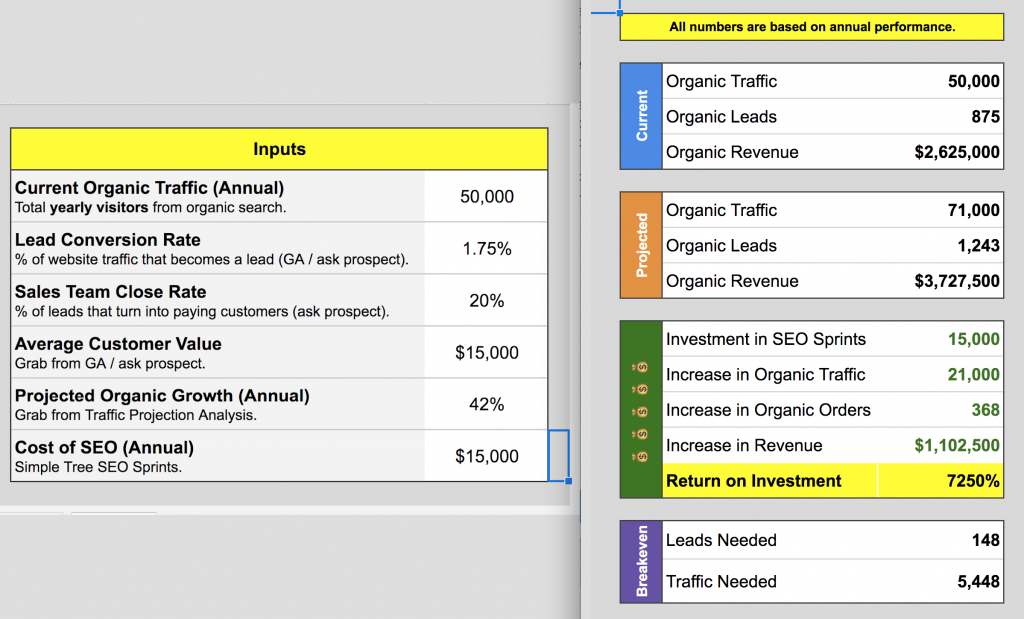
Solar SEO Sprints
To increase the value we deliver to our clients, in a manner that we would appreciate ourselves as business owners, we’ve created an SEO Sprint process, where we front load the most valuable and high impact work for one time project fees.
We have 4 Core SEO Sprints:
1) SEO Strategy Sprint
2) Google My Business Sprint
3) Content Sprint
4) Link Sprint
Each are designed to provide the most impact for specific project durations.
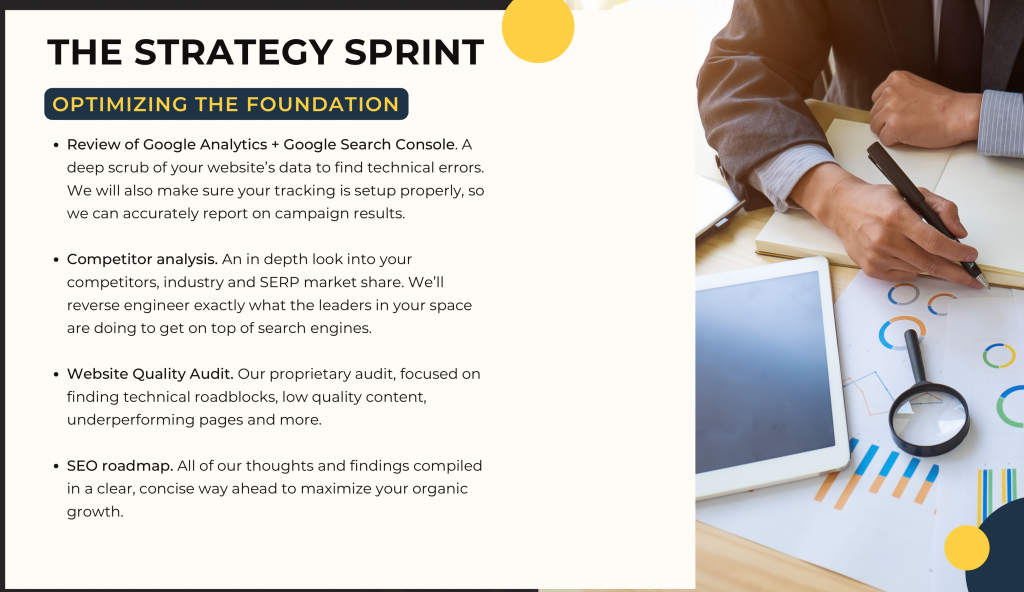
Interested in what our SEO services can do you for company? Request a free analysis with our traffic projection tool!
Why Organic Search and Google Maps
I wanted to create this post and video to share our exact organic digital strategy we deploy for our clients in building near term and long term lead generating assets.
Goal of this post is to help residential solar companies understand why investing in their own search marketing assets will yield a higher return on investment, higher quality leads, lower cost per lead, and increased brand equity compared to 3rd party lead buying, door knocking, or cold calling.
I was at SPI this year in Anaheim, and I was very surprised to learn how many solar installation companies weren’t investing in their own digital marketing. Most I spoke with both at the trade show and over the phone primarily use marketing budget for 3rd party leads, call centers, and door knocking. Although yes these produce results, (or else it wouldn’t be used), anecdotally I’ve seen cold calling and door knocking create a negative feeling toward he brand and solar as an industry itself. Spread throughout the U.S. are commission based, hungry salesmen knocking on doors, who can put off some customers who require a slower, education based approach. 3rd party leads are great to mix in your marketing budget, but should not be relied on exclusively, as your just allowing your competitors and lead gen companies to further dominate your local market and control the funnel.
Fact is most people begin their search for just about everything online. In between, we are glued to our phones browsing Linkedin or Instagram and the barrage of ads and information becomes normalized. Makes little sense why a solar company wouldn’t begin a program as it only continues to become more competitive and thus more expensive. The sooner you start iterating and testing now, the better.
Step 1: Verify New Google My Business Listings
The very first step we do when we bring on a client, is obtain new verified Google My Business (Google Maps) Listings across target cities in our client’s service area. We need to get these verified ASAP and let these “age” as much as we can (typically 2 weeks – 1 month ideally) before we begin any serious heavy lifting and optimization as to not trigger any manual inspections from the Google Team. While we are verifying these, we are optimizing and structuring the website for local search.
(Helping our client visualize and select which cities with verified Maps Listings would produce the most leads in their service area with Google MyMaps)
What’s a Google My Business/GMB/Google Maps Listing?
GMB stands for Google My Business. It’s a product that allows businesses to create verified listings to display on both Google Maps, and regular searches. Google is the most widely used search engine. One of it’s core features is it’s Google Maps. More often than not, local searches return a “Map Pack” at the top of Google, just below it’s paid ads.
This Opportunity Likely Won’t Last Forever!
As of fall 2018, we are able to obtain verified GMB listings across a client’s service area without requiring a physical office or mailbox in the target city. (traditionally what you need to verify a listing) This strategy is extremely powerful that very few other solar firms are utilizing. Effectively, it allows us to take advantage of the most prized piece of real estate in the digital space: above the fold visibility that requires no ad spend. Candidly, we don’t expect this strategy to last forever. Already I’ve heard from google employees personally, that this method is known internally, and they are doing everything they can to stop it. Google’s #1 priority is to be able to control it’s Search Engine Results Page 90% of it’s revenue is from Google Ads. It’s unknown how long this opportunity to secure permanent visibility on the most widely used search engine will last.
Wherever you have a physical office that can receive mail, you likely already have your Google My Business Listing (aka Google Maps Listing). Once verified, we can now we can begin to rank this in the 3 pack for our various key terms.
Getting a map listing is huge. Once we have a verified listing we can begin communicating all sorts of geo relevance back to our local page like building local citations, optimizing photos, a new brand network links specific to a city and begin to take over the first page for key solar searches with our brand.
We pair this with a website structured for to rank for local solar searches in a particular region. We can multi purpose our GMB for commercial solar searches as well.
This is how SolarReviews generates most of it’s leads is through organic search. Lucky for us, we can get above them using this Maps strategy.
Local Maps SEO – The Most Valuable Asset
Local Search Site Structure
Without delving to much into keyword research, and technical SEO on page, the key takeaways I want to give you is how we structure our website for local organic search, and local maps searches.
Page Structure
Page structure is all about making your website and topical (content), authoritative (links) source for all things solar + state/county/cities. It begins with writing and building city specific pages that target various solar searches; i.e. “solar installation {city}, solar companies {city}, solar contractor {city}, solar panels {city}”…etc.
This simple SEO strategy isn’t anything revolutionary, (SEOs reading this are probably rolling your eyes) but time and time again I come across residential solar sites with zero SEO strategy in place, essentially wasting their pages’ very existence. By building local SEO pages that target solar contracting in every city of your service area, you’re:
a) increasing brand visibility
b) increasing search traffic (once you’re on the first page)
c) adding more geo relevance to your site overall
d) increasing lead forms and calls from people already in your service area
e) putting all those hard earned backlinks to use with an on-page strategy
The steps to build these pages are simple.
1. Page Outline
Using keyword research to outline your page to rank for multiple iterations of the same keyword or “ad group”. Or emulate a competitor’s city page. Be aware of over optimization, learn about keyword densities or you can risk penalties.
2. Page Template
Taking the time to design out a Page that converts and can be replicated for all our city pages. We like to put our conversion oriented content above, and create an expand/hide div for our SEO text. Some best practices at a glance include:
- CTA Above the Fold
- Appointment Scheduler Sidebar
- Lead Magnet or Guide in Exchange for Email
- Messaging: Who are we speaking too? What is our offer?
- Multiple Calls to Action
- Trust Icons
- Credible Testimonials
Step 2: Deploy Paid Search Campaign
The fact is, results from SEO takes a little while (1-4 months depending on what kind of links your website has). The quickest way to start generating leads is through paid search either through Google Ads or if your service area is big enough (county wide, or multi-county) Facebook Ads. We’ve found Facebook Ads can produce qualified residential solar leads at around $20-$40 per lead, $50 on the high end. This is what most solar lead generation companies are using to drive leads for their clients, and selling these Facebook leads at around $100-$250 per lead, and around $350 for solar appointments. Rather than sending paid traffic to your main home page, we are big proponents of developing targeted landing pages with a single Call to Action on that page, testimonials (videos a plus), and all of our retargeting levers in place. Once we have a basic lander template developed, we can just duplicate this across our various campaigns.
a. Adwords Hacks – Bidding on Competitor Brands
This is our one our most favorite tactics for getting leads quick. In some regions (San Diego for example), keyword costs for the main solar keywords (“solar company, solar, solar panels”) can be quite expensive ($20-$30/click). So, one way to bid on cheaper, valuable keywords is to bid on other solar company names. Many solar company brand names get considerable search volume. Often more than basic local searches. We know these are targeted searches because people are researching a specific brand. The commercial intent is there. An easy way to grab this high commercial search intent is by bidding on competitor’s brand name. Often these are at much lower cost per clicks, and with a compelling landing page with a targeted offer, can be extremely effective in hijacking inbounds. This isn’t revolutionary, but a super effective and quick to get off the ground. We use SKAGs Adwords methodology to build all our PPC campaigns. You’ll also want to make sure you have all your proper conversion tracking set up, so you can accurately track which campaigns are producing calls and form submits.
Traditional Keyword Search & Pay Per Call Campaigns
Beyond bidding on competitor brands, we’re using SKAGs campaign structure, or “single keyword ad groups” for our search and mobile only pay per call campaigns.
All it is, is limiting your ad group to a single keyword, iterated with different match types:
[solar company]
“solar company”
+solar +company
In the ad headline, we repeat the keyword naturally in the Headline , description, and in the URL structure.
This pattern results in higher CTR as the ad stands out to the searcher.
(Contact me for an example ad happy to share)
To keep it brief, last really important takeaway is adding negative keywords. Don’t want our ad to be showing up for low commercial intent searches. Ask us for our master list for solar campaigns.
Call Tracking and Form Submits to Call Backs
Another really cool tool we use for our clients, is Jensen.ai, a call tracking software. This allows our partners to view all the calls we’ve generated for from our campaigns and listen to review call recordings. One of our most favorite features however, is the Form Submit to Lead Call Back feature.
For example, if someone fills out a “Request Solar Quote” form, Jensen does software magic, and auto-dials you (the partner). Jensen will then notify your trust sales person, “A new just filled out the form, would like to call them back?” Your sales man or women, then press 1 for yes, and Jensen will go back, call the Lead, and place both in a conference call. How cool is that?
To learn more about how to build one of these campaigns contact us.
Would You Like Feedback On Your Residential Solar Marketing?
We provide detailed In-bound Lead Generation Blueprints specific to your commercial solar firm. Request a Blueprint or Schedule a Call with Doug.
Transcript:
Hey, guys. Doug here with Simple Tree. I wanted to walk through a local SEO strategy that’s so easy to implement and not many residential solar firms are really using, or even commercial solar firms, but this search really works well for residential solar. It can be super easy to implement, and it’s a really low-hanging fruit that’s easily capitalized on. All it is, what I mean by local SEO, is just building out a page that targets a specific city, all for these various search terms. You can see here, these guys are doing this exact strategy, and you can see all their other city pages here, which has been working really well for them. Really, all it is to develop these pages, you can just reverse engineer what your competition is doing. You can see they’re pretty light on optimization here. You don’t need a whole lot to start ranking for these, but obviously, Houston’s a bit more competitive. You’re going to need some local backlinks, some geo-relevant and niche-relevant backlinks built to your entire domain and even the specific city page.
You can see here, there’s also a lot they can do to improve on, which we’ll go over in a bit, but right here, it’s just a quick example. It’s some keyword research we’re using to build out some of these pages. This is just exported from Google AdWords’ keyword planner. It really gives you a robust look at all the potential keywords to start going after, and maybe how to write pages to start targeting multiple keywords like this. You can see, we just color-coded these to help segment these topics, and this is just for the state of Colorado. You can do it statewide, nationwide. It really depends, but really, it would just be developing city pages that essentially duplicate this template. You’re going to want to make these all slightly unique, of course, but you get the picture. Once you have this basic template, here’s a template we wrote out for one of our clients for commercial solar. It’s really just structuring out overall what we’re trying to describe and what we want this page to rank for, and then we go in and have our writers fill in the gaps here.
For the residential local searches, it’s even simpler, especially for these maybe lower population cities and suburbs where competition really won’t be too intense, but you can still get some really easy wins. Supplementing on top of that would be ranking your map strategy, getting your map listing to rank with these local pages. If you have a verified map listing tied to these locations, you’re going to be a really powerful—you’re going to be able to come with a lot of ammunition to rank, because you have this map listing tied with your local page. Really, there’s some obviously quite a bit of strategy required into ranking these into a three-pack. It’s very competitive. You can see it has a lot to do with reviews and other local SEO tactics, but it can be done. It’s not impossible. My solution to you residential guys is, go out there and start building out these pages that target every city in your service area.
These are going to be really low-hanging fruit, especially for the non-competitive cities. Yeah, sure, the search volume won’t be there compared to a major city, but over time, these aggregate. That brand visibility does build over time, and you’re going to start generating calls. Beyond that, we have a service that can get verified map listing without requiring a physical address. This can be really huge for someone looking to scale their inbound leads because you can just grab a map listing, optimize it, build out your local page, time some local data to communicate with the both of them, and among a host of other things to get these to rank, which we’d be happy to walk through some of these tactics, but really, that’s the strategy, is getting your local visibility up there by building unique city pages and tying in a map listing to couple with that.
That’s going to be huge. These are the main call generators getting this kind of visibility. Beyond that, for low-hanging fruit, just start bidding on competitor key terms. Obviously, we know keywords like solar companies, solar installer, solar panels are going to be higher up there, but if you can start bidding on your competitors’ key terms, you’re not going to see as high of cost per click costs. We know the search relevance is going to be there because people are clearly looking for solar installation. They’re looking at competitors. That’s a really easy way to hack that visibility there, is using an AdWords campaign to go after your competitors. I’ll try to keep this short, but that’s really the gist of it. I’d be happy to explain to you more in-depth and give you a more concrete strategy of how to implement this and optimize it. Thank you. Let me know if you have any questions.

